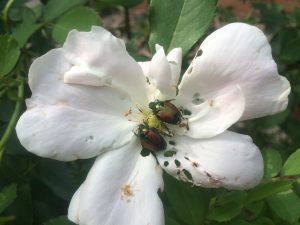Managing Japanese Beetle Adults & Grubs While Minimizing Impacts on Pollinators
Established in Wisconsin in the 1990s, the Japanese beetle (Popillia japonica) is a voracious defoliator of many landscape and garden plants. Roses, birches, lindens, grapes, raspberries, Norway maples, beans, apples, plums, crabapples, elms, beech, asparagus, and rhubarb are some of its favorite plant species. Typically, Japanese beetles begin to emerge in late June and early July in WI, with peak activity for six to eight weeks. Adult beetles are active during the daytime and can fly an average of 1 to 2 miles. The female beetles prefer to lay eggs in the soil of lawns and other turfgrass areas. The eggs hatch in about two weeks and the larvae (white grubs) feed on and can damage turfgrass.
Japanese beetles are tough to control in the landscape especially when bees and other beneficial insects are active during the same time. Following are some best management options to control Japanese beetle adults and grub that can minimize impacts on pollinators:
Landscape Trees & Shrubs:
- Although Japanese beetle feeding damage may be noticeable on landscape plants, well-established trees and shrubs generally tolerate damage without impacting bud emergence the following season. However, regular, severe defoliation can make some landscape plants more susceptible to secondary problems. Tree species like birch and lindens suffering from severe foliar feeding damage over years can attract native borers which can kill the stressed trees. To minimize the stress of defoliation on sensitive tree species, boost plant health during the growing season with water, nutrients and other proper tree care practices. For large trees with defoliation concerns, it is advisable to consult a certified arborist about management options.
- Small shrubs like roses and young Japanese maples can be protected using nylon insect screens (mesh size less than or equal to ¼”) from late June to early September over the plant and securing the edge of the screen to the ground.
- Hand-picking or knocking the beetles into a container of soapy water can be helpful for small plants when limited numbers of adult beetles are present in a yard or garden.
- Acelepryn (Chlorantraniliprole) is a reduced risk insecticide product and is effective in controlling adult beetles on ornamental plants as a foliar application. It has low toxicity to bees, other pollinators, pets, and humans. Read the product label for spray application instruction.
- Pheromone lure traps are not recommended for Japanese beetles. Such traps can indeed capture large numbers of Japanese beetles, but attract many more to the general area, which can result in additional damage.
- Choosing less-favored plant species can minimize the impact of Japanese beetles in the landscape. Plants like arborvitae, boxwood, clematis, dogwood, forsythia, hemlock, hickory, holly, juniper, lilac, magnolia, northern red oak, pine, red maples, sweetgum, tulip tree, and yews have shown lesser feeding damage to Japanese beetle. (Referenced from Iowa State University Extension).
- Bacillus thuringiensis galleriae (Btg) is a bio-insecticide which can help protect foliage from adult Japanese beetles. It can be found in the product beetleGONE!, which is approved for organic production. Btg has a broad label and can be used on a wide range of landscape plants.
- Organic insecticides containing azadirachtinor pyrethrins can be sprayed on landscape plants in the late evening once pollinator activity subsides. Repeat the application as needed according to the product label until the beetle activity subsides for the season. Be sure to read the insecticide product label for its instruction and safety precautions.
Fruits & Vegetables:
- Hand-picking or knocking the beetles into a container of soapy water can be helpful for small plants when limited numbers of adult beetles are present in a yard or garden.
- Bacillus thuringiensis galleriae (Btg) is a bio-insecticide which can help protect foliage from adult Japanese beetles. It can be found in the product beetleGONE!, which is approved for organic production. Btg has a broad label and can be used on a wide range of vegetables and fruits. Be sure to read the insecticide product label for its instruction, post-harvest interval period and safety precautions.
- Organic insecticide containing azadirachtin or pyrethrins can be sprayed on vegetables and berry crops in the late evening once pollinator activity subsides. Repeat the application as needed according to the product label until the beetle activity subsides for the season. Be sure to read the insecticide product label for its instruction, post-harvest interval period and safety precautions.
- Pheromone lure traps are not recommended for Japanese beetles. Such traps can indeed capture large numbers of Japanese beetles, but attract many more to the general area, which can result in additional damage.
Turf:
- Withhold turf irrigation from July to mid-August when the beetles are in their peak active season. This may help in preventing the adult beetles from laying their eggs in dry turf areas.
- Mow any flowering weeds before scheduling liquid applications of preventive or curative grub treatment products in turf areas. This will minimize the spray impact on any foraging bee activity during application periods.
- Mowing of flowering weeds is not needed if using granular or pelleted grub treatment products in the turf followed by light irrigation to move the product into the thatch layer. Another option is to use the reduced risk insecticide product Acelepryn followed by light irrigation as preventive grub treatment application in turf.
- Use of biological control products like Bacillus papillae (Milky spores), fungal organisms like Beauveria bassiana and Metarrhiizium brunneum, and entomopathogenic nematodes have provided inconsistent control of Japanese beetle grubs in field tests. The effectiveness of the biological control products can be greatly influenced by environmental conditions including temperature, soil type, soil moisture, and pH.
By Vijai Pandian, UW Madison Extension and PJ Liesch, UW Madison Entomology, https://milwaukee.extension.wisc.edu/2019/07/22/how-to-deal-with-japanese-beetles/




